
KPI – November 2023: The Brief
KPI – November 2023: State of Manufacturing
KPI – November 2023: State of Business – Automotive Industry
KPI – November 2023: Consumer Trends
In October, the Consumer Price Index for All Urban Consumers (CPI-U) was unchanged on a seasonally adjusted basis, says the U.S. Bureau of Labor Statistics. Over the last 12 months, the all-items index increased 3.2% before seasonal adjustment.
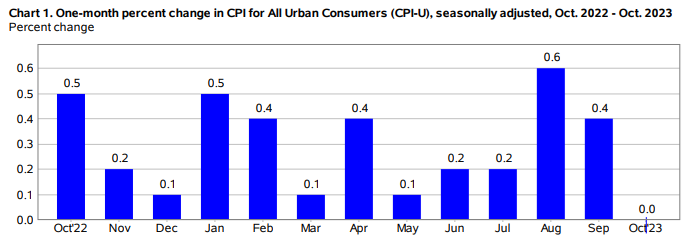
Important Takeaways, courtesy of the U.S. Bureau of Labor Statistics:
- The index for shelter continued to rise in October, offsetting a decline in the gasoline index and resulting in the seasonally adjusted index being unchanged month-over-month.
- The energy index declined 2.5%, while the food index increased 0.3%, after rising 0.2% in September.
- Indexes on the rise include rent, owners’ equivalent rent, motor vehicle insurance, medical care, recreation and personal care. The indexes for lodging away from home, used cars and trucks, communication and airline fares were among those to decrease month-over-month.
- The all-items index increased 3.2% year-over-year, while the all-items-less-food-and-energy index rose 4%. The energy index decreased 4.5%, but food increased 3.3% year-over-year.
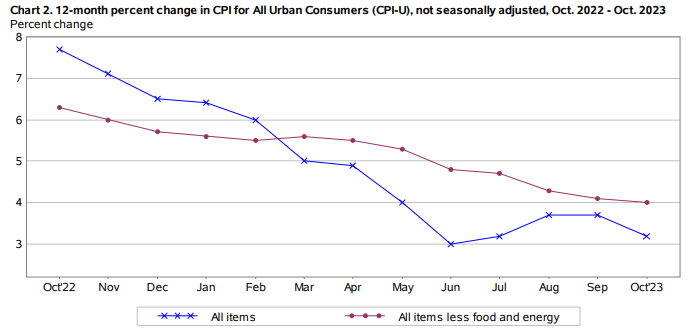
EMPLOYMENT
Total nonfarm payroll employment increased by a meager 150,000 in October–significantly below last month’s figure, with multiple sectors posting minimal or negative growth. According to leading economists, this month’s report is representative of “a cooling labor market” in the U.S.
The unemployment rate and number of unemployed persons ticked up to 3.9% and 6.5 million, while the labor force participation rate and the long-term unemployed (those jobless for 27 weeks or more) edged up to 62.7% and 19.8%, respectively, according to the U.S. Bureau of Labor Statistics.
In addition, data shows that wages posted a modest 0.2% month-over-month advance, the smallest gain since February 2022–marking a downshift from the three-month trailing average of 0.3%. Economists predict wage pressures will chill further in the months ahead, particularly as labor market conditions deteriorate and the demand for employees balances with a limited pool of available workers.
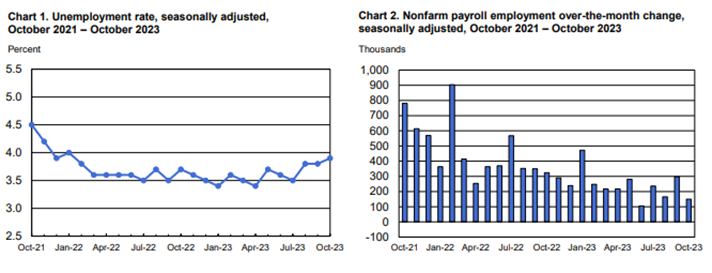
In addition, current data also shows steep downward revisions in job growth at the end of the summer. Gains for August and September were revised down by a total of 101,000 jobs to a respective 165,000 and 297,000, suggesting the labor market is weaker than it previously appeared.
“The October jobs report showed a clear softening in labor market conditions, with markedly slower hiring, cooling wage growth, an uptick in the unemployment rate and a shorter workweek,” says Lydia Boussour, EY chief economist. “Looking ahead, we foresee softer labor market conditions with further hiring freezes and strategic resizing decisions, along with some continued moderation in nominal wage growth.”
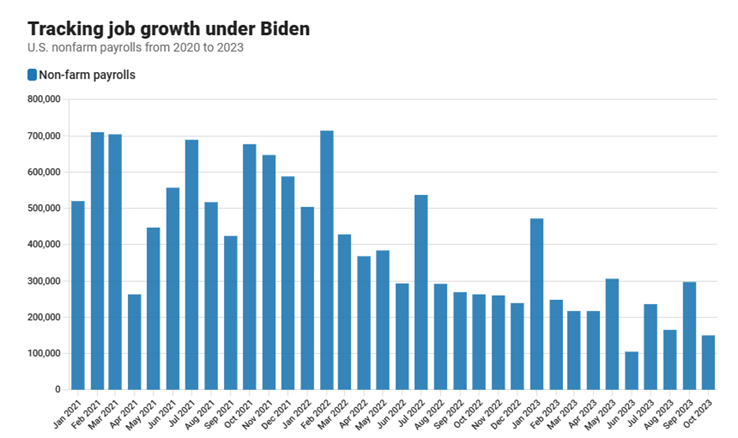
Source: U.S. Bureau of Labor Statistics data
BY DEMOGRAPHIC
This month, unemployment rates among the major worker groups: adult women–3.3%, adult men–3.7%, teenagers–13.2%, Asians–3.1%, Whites–3.5%, Hispanics–4.8% and Blacks–5.8%.
Last month, unemployment rates among the major worker groups: adult women–3.1%, adult men–3.8%, teenagers–11.6%, Asians–2.8%, Whites–3.4%, Hispanics–4.6% and Blacks–5.7%.
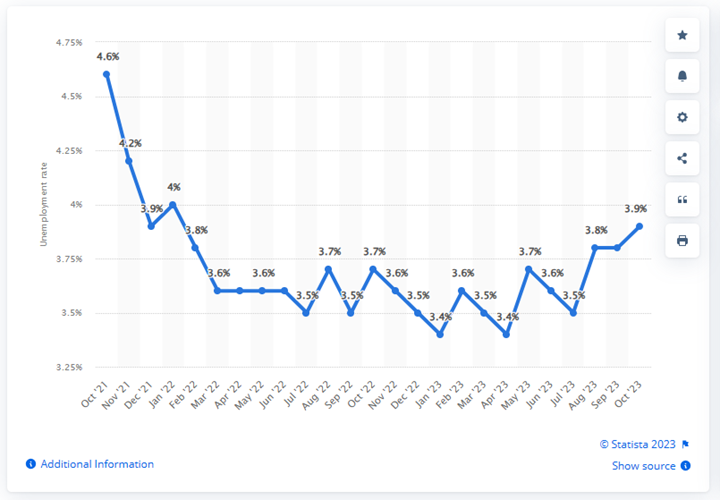
Caption: The seasonally adjusted national unemployment rate is measured on a monthly basis in the U.S. In October 2023, the national unemployment rate was 3.9%. Seasonal adjustment is a statistical method of removing the seasonal component of a time series that is used when analyzing non-seasonal trends.
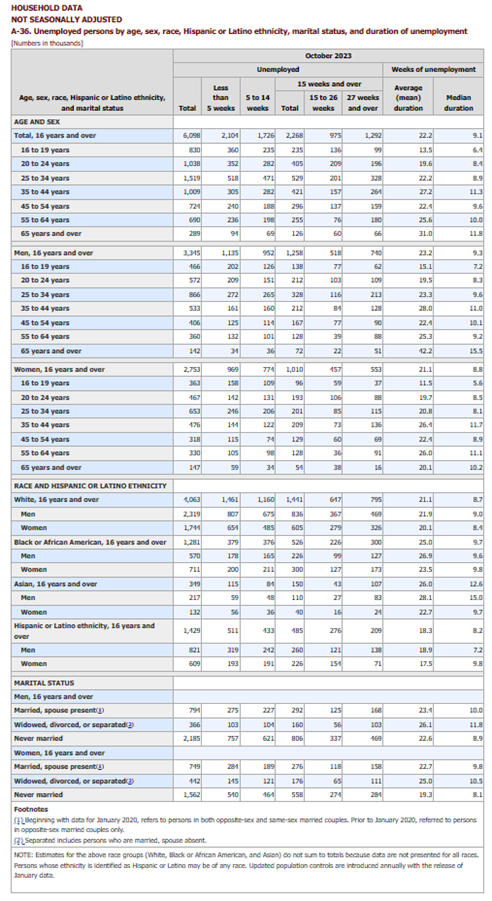
BY INDUSTRY
In October, job gains occurred in health care, government and social assistance, while manufacturing, transportation and warehousing continued to slide. For context, approximately 51,000 of the 150,000 total monthly job gains are attributed to government–one-third of the documented growth.
“The Employment Trends Index ticked down slightly in October and has been on a declining trend since it reached its peak in March 2022,” says Selcuk Eren, senior economist at The Conference Board. “While changes have been minimal month-to-month and the index remains elevated, there are signs of cooling as recent job gains have been mostly concentrated in industries facing major labor shortages, including in-person services and government. If labor markets continue cooling and wage growth slows further, the Federal Reserve may be done with interest rate hikes for the current tightening cycle.”
According to Eren, industries that have not fully recovered from the pandemic, such as leisure & hospitality and government, will continue to experience job growth. He expects job growth also will stay positive in health care and social assistance due to labor shortages and an aging U.S. population.
Elsewhere, economists see declines in labor demand, especially in industries that notably boomed during the start of the pandemic. Eren points to information services, finance and insurance, plus manufacturing, transportation and warehousing, as examples of industries shedding jobs in October. Such developments are observed in several components of the Employment Trends Index, with declines in job openings, a higher share of involuntary part-time workers, as well as a small uptick in initial claims for unemployment.
“Looking ahead, we continue to project a short-lived recession in 2024, as real GDP growth turns negative, but with minimal impact on the unemployment rate, which is expected to rise to 4.2% by mid-2024,” Eren says.
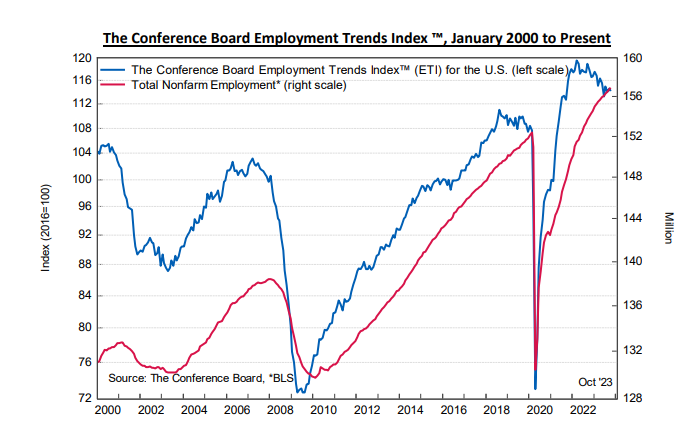
Caption: The Conference Board Employment Trends Index (ETI) decreased in October to 114.16, from a downwardly revised 114.63 in September. The Employment Trends Index is a leading composite index for employment. When the Index increases, employment is likely to grow as well, and vice versa. Turning points in the Index indicate that a change in the trend of job gains or losses is about to occur in the coming months.
Important Takeaways, courtesy of the U.S. Bureau of Labor Statistics:
- Health care added 58,000 jobs in October. Employment continued to trend up month-over-month in ambulatory health care services (+32,000), hospitals (+18,000), as well as nursing and residential care facilities (+8,000).
- Employment in government increased by 51,000, returning to its pre-pandemic February 2020 level.
- Social assistance added 19,000 jobs, compared with an average monthly gain of 23,000 over the prior 12 months. Employment continued to trend up month-over-month in individual and family services (+14,000).
- Employment in construction continued to trend up (+23,000), particularly in specialty trade contractors (+14,000) and construction of buildings (+6,000).
- Employment in manufacturing decreased by 35,000 in October, reflecting a decline of 33,000 in motor vehicles and parts that was largely due to strike activity.



